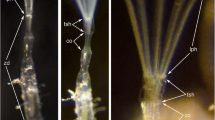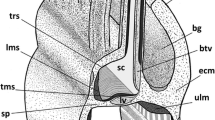Abstract
The architecture and function of the lophophore of the marine bryozoan Cryptosula pallasiana (Moll) are described, including some new features not previously discovered in bryozoans. The nature of fluid movements within the lophophoral coelom during feeding activities is postulated on the basis of the arrangements of epithelia and muscles. Epithelial cells at the tentacle bases are blastemic in nature, and there is a ciliated pit of unknown function in the angle between every pair of tentacles. There are 6 nerves in each tentacle, including a pair of single-axon subperitoneal nerves. Neurosecretory-like vesicles and glycogen occur in some neurons of the ganglion. The basal lamina collagen has a diameter smaller than that previously recorded for an invertebrate. Filament dimensions are given for several different muscles. Tentacle muscles and lophophore retractor muscles are smooth. Thick paramyosin-like filaments up to 75 nm diameter occur in two muscle types. A new set of muscles is described: the basal transverse muscles of the tentacles.
Similar content being viewed by others
Literature Cited
Balazs, E.A. (Ed.): Chemistry and biology of the intercellular matrix, Vol. 1. 698 pp. New York: Academic Press 1970
Borg, F.: Studies on recent cyclostomatous Bryozoa. Zool. Bidr. Upps. 10, 181–507 (1926)
Brien, P.: Classe des bryozoaires. Traité Zool. 5, 1054–1335 (1960)
Bronstein, G.: Étude du système de quelques bryozoaires gymolémides. Trav. Stn biol. Roscoff 5, 155–174 (1937)
Bullivant, J.S.: Release of sperm by Bryozoa. Ophelia 4, 139–142 (1967)
— The method of feeding of lophophorates (Bryozoa, Phoronida, Brachiopoda). N.Z. Jl mar. Freshwat. Res. 2, 135–146 (1968)
Burnstock, G. and T. Iwayama: Fine-structural identification of autonomic nerves and their relation to smooth muscle. Prog. Brain Res. 34, 389–404 (1971)
Calvet, L.: Contribution à l'histoire naturelle des bryozoaires ectoproctes marins. Trav. Inst. Zool. Univ. Montpellier 8, 1–488 (1900)
Dilly, P.N.: The structures of the tentacles of Rhabdopleura compacta (Hemichordata) with special reference to neurociliary control. Z. Zellforsch. 120, 20–39 (1972)
Dorey, A.E.: The organisation and replacement of the epidermis in acoelous turbellarians. Q. Jl microsc. Sci. 106, 147–172 (1965)
Emscherman, P.: Cuticular pores and spines in the Pedicellinidae and Barentsiidae (Entoprocta), their relationship, ultrastructure, and suggested function and their phylogenetic evidence. Sarsia 50, 7–16 (1972)
Fawcett, D.W.: Structural specialisations at the cell surface. In: Frontiers in cytology, pp 19–41. Ed. by S.L. Palay. New Haven: Yale University Press 1958
—: Cilia and flagella. In: The cell: biochemistry, physiology, morphology, Vol. 2. pp 217–297. Ed. by J. Brachet and A.E. Mirsky. New York: Academic Press 1961
Gärtner, J.: The normal fine structure and aging changes of the human zonular fibers with special regard to the degeneration of collagen in senile ciliary body and in Pinguecula. Z. Zellforsch. 114, 281–300 (1971)
Gibbons, I.R.: The relationship between the fine structure and direction of beat in gill cilia of a lamellibranch mollusc. J. biophys. biochem. Cytol. 11, 179–205 (1961)
Graupner, H.: Zur Kenntnis der feineren Anatomie der Bryozoen (Nervensystem, Muskulatur, Stützmembran). Z wiss. Zool. 136, 38–77 (1930)
Harmer, S.F.: On the development of Tubulipora, and on some British and northern species of this genus. Q. Jl microsc. Sci. 41, 73–157 (1898)
Hincks, T,: A history of the British marine Polyzoa, Vol. 1, 601 pp. Vol. 2. 83 pl., London: van Voorst 1880
Lowy, J.: Contraction and relaxation in the adductor muscles of Mytilus edulis. J. Physiol. 120, 129–140 (1953)
Lutaud, G.: Le ‘plexus’ pariétal de Hiller et la coloration du système nerveux par le bleu méthylène chez quelques bryozoaires chilostomes. Z. Zellforsch. 99, 302–314 (1969)
—: L'innervation du lophophore chez le bryozoaire chilostome Electra pilosa (L.). Z. Zellforsch. 140, 217–234 (1973)
Mangum, C.P. and T.J.M. Schopf: Is an ectoproct possible? Nature, Lond. 213, 264–266 (1967)
Marcus, E.: Beobachtungen und Versuche an lebenden Meeresbryozoen. Zool. Jb. (Abt. Syst. Ökol. Tiere) 52, 1–102 (1926)
—: Bryozoarios marinhos brasileiros III. Bolm Fac. Filos. Ciênc. S Paulo (Zool.) 3, 111–354 (1939)
Matricon, I.: Dégénérescence du polypide femelle et formation d'une poche incubatrice chez Alcyonidium polyoum (Hassall) (bryozoaire cténostome). Archs Zool. exp. gén. 102, 79–93 (1963)
Menton, D.N. and A.Z. Eisen: The structure of the integument of the sea cucumber Thyone briareus. J. Morph. 131, 17–36 (1970)
Otto, F.: Studien über das regulationsvermögen einiger Süsswasserbryozoen. Arch. EntwMech. Org 47, 399–442 (1921)
Pearse, A.G.E.: Histochemistry, theoretical and applied, 3rd ed. Vol. 1. 759 pp. London: J. & A. Churchill Ltd 1968
Reynolds, E.S.: The use of lead citrate at high pH as an electron-opaque stain in electron microscopy. J. Cell Biol. 17, 208–212 (1968)
Richards, J.R.: The ciliary feeding mechanism of Neothyris lenticularis (Deshayes). J. Morph. 90, 65–91 (1952)
Rogick, M.D.: Studies on freshwater Bryozoa VI. The finer anatomy of Lophodolla carteri var. typica. Trans. Am. microsc. Soc. 56, 367–396 (1937)
Selys Longchamps, M. de: Phoronis. Fauna Flora Golf. Neapel 30, 1–281 (1907)
Sherman, R.G.: Muscle attachments in horseshoe crab walking legs. Biol. Bull. mar. biol. Lab., Woods Hole 146, 88–99 (1974)
Sievers, J.: Basic two-dye stains for epoxyembedded 0.3–1 μ sections. Stain Technol. 46, 195–199 (1971)
Silbermann, S.: Untersuchungen über den feineren Bau von Alcyonidium mytili. Arch. Naturgesch. 72, 265–310 (1906). [Paper not read by author]
Silén, L.: Fertilisation in the Bryozoa. Ophelia 10, 27–34 (1972)
Smith, J.W. and A. Seraffini-Fracassini: The relationship of hyaluronate and collagen in the bovine vitreous body. J. Anat. 101, 99–112 (1967)
Smith, L.W.: Ultrastructure of the tentacles of Flustrellidra hispida. In: Living and fossil Bryozoa, pp 335–342, Ed. by G.P. Larwood. London: Academic Press 1973
Strathmann, R.: Function of lateral cilia in suspension feeding of lophophorates (Brachiopoda, Phoronida, Ectoprocta). Mar. Biol. 23, 129–136 (1973)
Tamm, S.L. and G.A. Horridge: The relation between the orientation of the central fibrils and the direction of beat of Opalina. Proc. R. Soc. (Ser. B) 175, 219–233 (1970)
Trump, B.F., E.A. Smuckler and E.P. Benditt: A method for staining epoxy sections for light microscopy. J. Ultrastruct. Res. 5, 343–348 (1961)
Van Beneden, P.J.: Recherches sur l'organisation des Laguncula et l'histoire naturelle des differents polypes bryozoaires qui habitent la cîte d'Ostende. Mém. Acad. r. Sci. Lett. Belg. 18, 3–29 (1845)
Zimmer, R.L.: Morphological and developmental affinities of the lophophorates. In: Living and fossil Bryozoa, pp 593–599. Ed. by G.P. Larwood. London: Academic Press 1973
Author information
Authors and Affiliations
Additional information
Communicated by J.H.S. Blaxter, Oban
Rights and permissions
About this article
Cite this article
Gordon, D.P. Microarchitecture and function of the lophophore in the bryozoan Cryptosula pallasiana . Mar. Biol. 27, 147–163 (1974). https://doi.org/10.1007/BF00389068
Accepted:
Issue Date:
DOI: https://doi.org/10.1007/BF00389068




